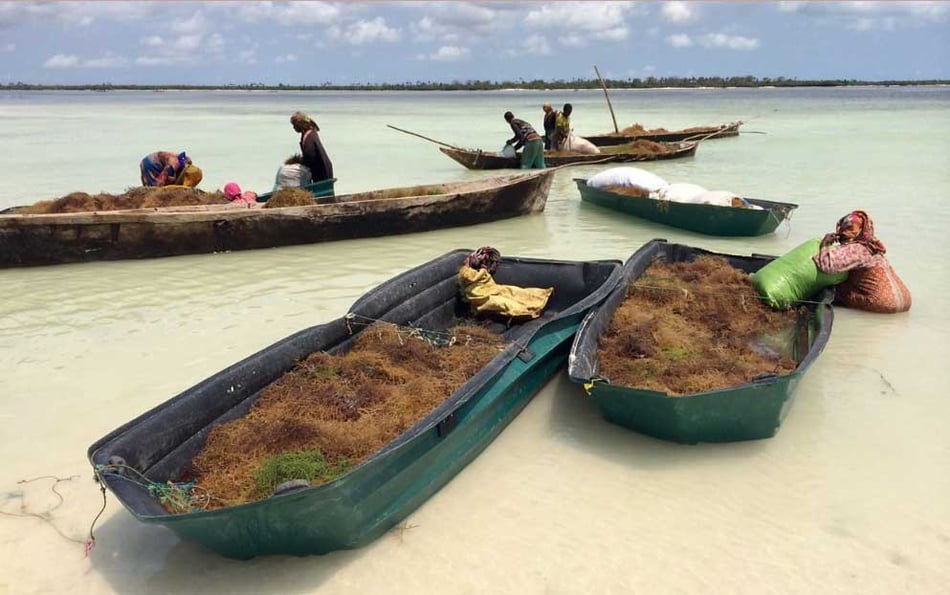The Seaweed Solution: Growing Green Waves for a Sustainable Future

Tin
2
min. read

Aquaculture - the farming of aquatic organisms - is a vital industry that addresses the growing demand for seafood while promoting environmental sustainability, if it is done right. Similar to this, seaweed farming involves the cultivation of various species of algae in controlled oceanic environments. Unlike traditional agriculture, seaweed farming does not require vast expanses of land or excessive freshwater usage. Instead, it harnesses the power of the ocean to grow one of nature's greenest and most versatile resources. This method of marine farming has emerged as a game-changer in fostering sustainable aquaculture, offering unique benefits that contribute positively to the marine ecosystem.
Seaweeds, which are actually algae, are photosynthetic organisms that absorb carbon dioxide (CO2) during growth, and they are highly efficient at absorbing CO2 compared to terrestrial plants. Their fast growth rates, large surface areas, and direct exposure to CO2-rich seawater enable them to take up significant amounts of carbon. Unlike trees and other land-based plants, seaweeds do not undergo seasonal cycles that cause fluctuations in CO2 absorption. They can continue to sequester carbon throughout the year, offering consistent and reliable processes. These unsung heroes can also live for several years, and their biomass remains stable and intact during their lifespan. As a result, the carbon stored within the seaweed remains sequestered for an extended period, providing a valuable long-term reservoir.

Seaweed farmers in Northern Pemba head back, unloading their boats full of freshly harvested Spinosum
Seaweed farming also provides livelihood opportunities for coastal communities, particularly in developing countries. It requires minimal investment and can be practiced by small-scale farmers with limited resources. The cultivation and sale of seaweed leads to income diversification, gender equity, and improved socio-economic conditions for communities. This also helps coastal communities become more invested in protecting their local marine environments. Seaweed farmers often act as stewards of the sea, actively participating in conservation efforts and monitoring the health of their coastal ecosystems.
In addition to all this, seaweed also holds great potential as a sustainable and eco-friendly alternative to conventional aquafeeds. Several species of seaweed are rich in essential nutrients, minerals, and proteins required for the growth of various species. A 2018 study showed that feeding aquaculture species with seaweed-based diets can lead to improved growth rates, enhanced immune systems, and better muscle quality. Incorporating seaweed into fish and shrimp diets can reduce the reliance on fishmeal and fish oil derived from wild-caught species, thus reducing pressure on marine resources and enhancing the sustainability of aquaculture practices.
Seaweeds may be relatively simple organisms, but they hold outsized power when it comes to making the most of Earth’s resources. Embracing the eco-friendly practice of seaweed farming offers a promising future for both the aquaculture industry and the preservation of our oceans. With continued research and investment, seaweed farming can unlock the full potential of sustainable aquaculture and contribute significantly to a more resilient and prosperous future for coastal communities worldwide.
The IMARCS Foundation aims to help usher in a brighter future by spearheading innovative solutions in the fields of mariculture and marine conservation. Seaweed farming and the multifaceted benefits that come from this accessible and sustainable practice resonate deeply with our mission and vision.
For more on our first-of-its-kind inshore mariculture project.
Sources:
Davies, S. J., Soler-Vila, A., Fitzgerald, R., Johnson, M. P., & Wan, A. H. L. (2018). Macroalgae as a sustainable aquafeed ingredient. Reviews in Aquaculture, 11(3), 458–492.
Krause-Jensen, D., & Duarte, C. M. (2016). Substantial role of macroalgae in marine carbon sequestration. Nature Geoscience, 9(10), 737–742.
Magembe, L. (2020, July 14). The promise of Restorative Aquaculture Solutions. The Nature Conservancy. https://www.nature.org/en-us/what-we-do/our-insights/perspectives/restorative-aquaculture-seaweed-farms-tanzania/
Mesbah, M. (2023, April 20). Coastal community perspectives on seaweed farming. Sea Going Green. https://www.seagoinggreen.org/blog/coastal-community-perspectives-on-seaweed-farming
Wan, A. H. L., Davies, S. J., Soler-Vila, A., Fitzgerald, R., & Johnson, M. P. (2018). Macroalgae as a sustainable aquafeed ingredient. Reviews in Aquaculture, 11(3), 458–492.